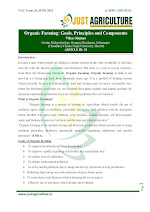Role of Nutrients, Deficiency Symptoms, Disorder and Available Forms
(1). Nitrogen
- Basic component of proteins and chlorophyll (the pigment that gives plants their green colour).
- Plays an essential role in plant growth.
- Also feeds microorganisms in the soil
Deficiency
- Lower leaves become yellow and dries.
- V shaped chlorosis on older leaves or yellowing at tip.
Disorder
- Starvation disease due to nitrogen deficiency.
- Buttoning in cauliflower.
(2). Phosphorous
- Plays an important role in root growth and promotes the establishment of young plants, flowering, fruiting and ripening, photosynthesis, respiration and overall plant growth.
Deficiency
- Due to deficiency of single element the life cycle of plant can't be completed hence Phosphorus is called " key of life "
- Deficiency imparts dark green colour in leaves.
- Later develops red purple colourration.
Disorder
- Sickle leaf diseases.
(3). Potassium
- Moves through the plant. Promotes the movement of sugars, turgor and stem rigidity.
- Also increases the plant’s overall resistance to cold, diseases, insect pests, etc.
- Promotes the formation of flower buds, the hardening-off of woody plants and fruiting.
Deficiency
- Spot of dead tissue at tips.
- Scorching and burning on margins of autumn leaves.
Disorder
- Rottle/ dieback disease.
(4). Calcium
- It is constituent of cell wall
- Calcium is a mobile in plants and deficiency symptoms appear on Meristem tip portion.
Deficiency
- Terminal bud die
Disorder
- Tip hooking.
- Blossom end rot of tomato(BER).
- Popping in groundnut.
(5). Magnesium
- An important part of chlorophyll.
- Helps fruit ripen and seeds germinate.
- Reinforces cell walls and promotes the absorption of phosphorous, nitrogen and sulphur by plants
Disorder
- Sand -drown disease of tobacco.
(6). Sulphur
- A component of several proteins, enzymes and vitamins.
- Contributes to chlorophyll production.
- Helps plants absorb potassium, calcium and magnesium.
Disorder
- Akiochi disease of rice due to Excess of hydrogen sulphide.
- Tea yellow disease of tea.
(7). Iron
- Essential to chlorophyll production.
- Also contributes to the formation of some enzymes and amino acids.
Deficiency
- Interveinal complete chlorosis.
- Scorching of leaf margin.
- Yellowing of iron chlorosis in groundnut.
(8). Manganese
- Promotes seed germination and speeds plant maturity. Plays an important role in photosynthesis by contributing to chlorophyll production. Essential for nitrogen assimilation and protein formation.
Deficiency
- Dead spot on leaves.
Disorder
- Marsh spot of pea.
- Pahala blight of sugarcane.
(9). Copper
- Compound of plastocyanin.
- Essential for photosynthesis/ respiration
- Dieback and reclamation disease of cereals.
(10). Boron
- Essential to overall plant health and tissue growth.
- Promotes the formation of fruit and the absorption of water
- It is necessary for translocation of Sugars and is involved in reproduction and germination of pollen.
- Browning of cauliflower is caused by Boron deficiency.
- Top sickness of tobacco.
- Fruit cracking of tomato.
- Hard fruit of citrus.
- Hen and chicken disease of grape.
(11). Zinc
- Plays an important role in the synthesis of proteins, enzymes and growth hormones.
- Zn deficiency causes-
- White bud of maize.
- Khaira disease of rice.
- Little leaf of cotton.
- Mottled leaf of citrus.
- Rosette formation.
(12). Cobalt
- It is component of Vitamin B
- It is essential for formation of type of hemoglobin in N-fixing nodule tissue known as leghemoglobin.
- Act as O2 carrier in roots.
- Also known as animal protein factor
(13). Molybdenum
- Essential for nitrogen assimilation by plants and nitrogen fixation by bacteria.
- This means that it is needed for the production of nitrogen-based proteins.
- It is absorbed as molybdate MoO4-2 forms.
- Whiptail of cauliflower is due to deficiency of Mo.
- Mo is required for carrot & raphanus for sweetness.
(14). Nickel
- Key component of selected enzymes involved in N metabolism and biological N fixation.
(15). Chlorine
- Stimulates photosynthesis
Forms of nutrient element absorbed by plants
C - Mainly through leaves - CO2
H - HOH (Hydrogen from H2O)–H+
O - CO2 mainly through leaves – O2-,OH-
,(CO3) 2-
N - NH4
+
, NO3
K - K+
Ca - Ca2+
Mg - Mg2+
S - (SO4)2-
Fe - Fe2+ (Ferrous), Fe3+ (Ferric)
Mn - Mn2+ (Manganous), Mn4+ (Manganic)
Zn - Zn2+
Cu - Cu+(Cuprous), Cu2+ (Cupric)
Co - Co2+
Na - Na+
Si - Si(OH)4
Cl - Cl-
B - H3BO3 (Boric acid) H2BO3 (Borate)
Mo - (MoO4)2-
Thank You
Vikas Kashyap:)
Contact Us










0 Comments